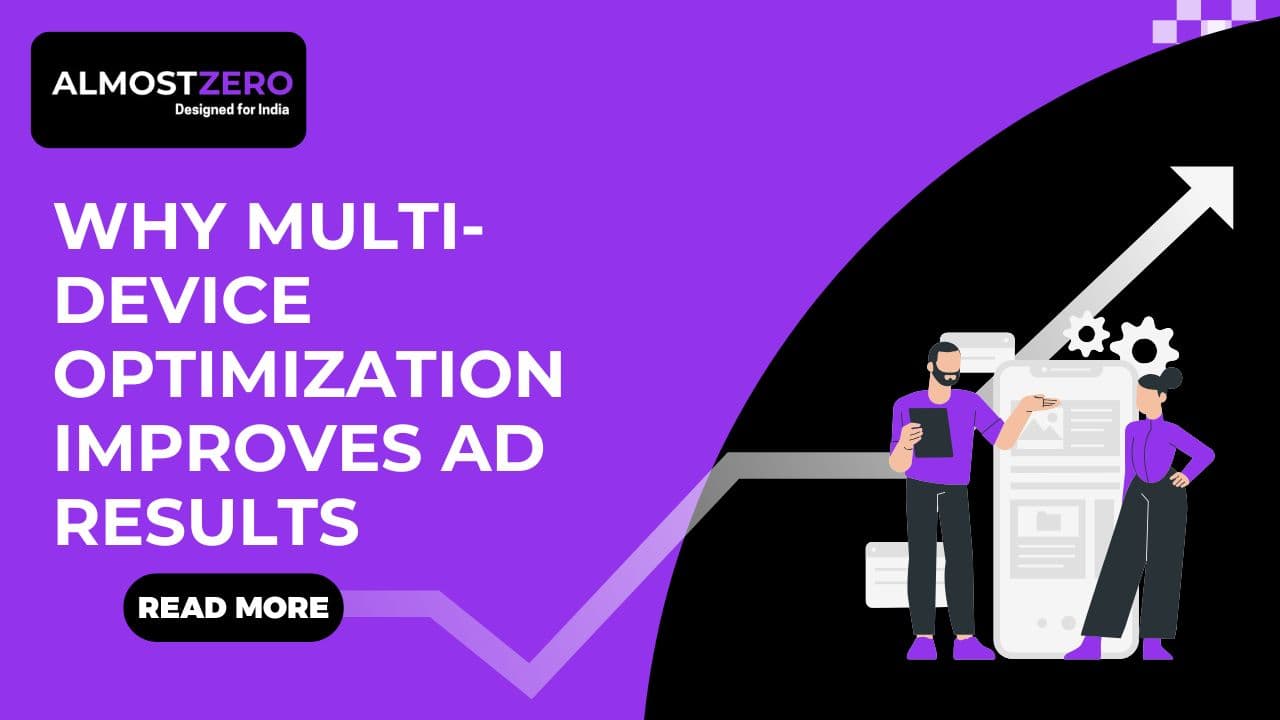AlmostZero.io Why Multi-Device Optimization Improves Ad Results

Why Multi-Device Optimization Improves Ad Results
In 2025, customers no longer stick to one device when browsing or shopping. They might see your ad on their mobile, check reviews on a laptop, and finally complete the purchase on a tablet. This multi-device behavior has become the new normal. Yet, many advertisers still design campaigns that look good only on one platform—usually mobile. The result? Broken experiences, higher drop-offs, and wasted ad spend. That’s why multi-device optimization is no longer optional—it’s essential. Optimizing ads for every screen ensures your brand delivers consistent, smooth, and persuasive experiences that improve results. Let’s explore why multi-device optimization matters and how it directly boosts ad performance.
1. Customers Switch Devices Constantly
A user might click your ad on mobile while commuting but complete the purchase later on their laptop. If your ad or landing page isn’t optimized for both, you lose the sale. Multi-device optimization makes sure that whether someone views on a 6-inch phone or a 15-inch laptop, the experience is seamless.
2. Mobile Still Dominates, But Desktop Matters
While 70–80% of ad traffic comes from mobile, desktops still play a major role in conversions, especially for higher-ticket purchases. People often research on mobile but complete big transactions on desktops. Ads that perform well across both deliver higher ROI.
3. Better Engagement With Responsive Creatives
An ad designed for desktop may look cluttered on a small screen. A mobile ad might look too stretched on larger devices. Multi-device optimization ensures creatives are responsive—images, videos, and CTAs automatically adjust to fit the device without losing impact.
4. Improves CTR With Device-Specific Placements
Different devices favor different placements. For example:
- Mobile: Reels, Stories, and in-app ads perform best.
- Desktop: Right column and feed ads get more clicks.
- By optimizing placements for each device, you maximize CTR and reduce wasted impressions.
5. Reduces Drop-Offs on Landing Pages
Nothing kills conversions faster than a page that doesn’t load properly on a device. Multi-device optimization ensures your landing page is:
- Mobile-Friendly: Fast load speed, easy navigation, short forms.
- Desktop-Friendly: Rich visuals, detailed information, and trust signals.
- Smooth user experience across devices reduces bounce rates and increases conversions.
6. Consistent Brand Experience Builds Trust
When customers see your ad on one device and revisit later on another, the look, feel, and message should stay consistent. Multi-device optimization ensures your brand voice is uniform, which builds trust and confidence to purchase.
7. Boosts Retargeting Performance
Retargeting relies on tracking customers across devices. If ads and landing pages aren’t optimized everywhere, retargeting loses effectiveness. Multi-device-friendly campaigns make sure your brand follows users seamlessly from mobile to desktop, closing more sales.
8. Prepares You for New Devices
With smart TVs, wearables, and tablets gaining popularity, ads need to adapt beyond just phones and laptops. Brands that optimize for all devices stay ahead, ensuring they don’t lose customers exploring on newer screens.
Best Practices for Multi-Device Optimization
- Design Mobile-First but Adapt for Desktop: Mobile is primary, but don’t ignore desktop experience.
- Use Vertical and Horizontal Creatives: 9:16 for mobile, 16:9 or 1:1 for desktops.
- Test Ads Across Devices: Always preview creatives in Ads Manager for mobile, desktop, and placements.
- Shorten Forms on Mobile: Keep it simple for smaller screens.
- Maintain Visual Consistency: Use the same brand colors, fonts, and messaging across devices.
Real-World Example (Generic Scenario)
A travel agency ran a campaign optimized only for mobile. Users clicked ads but dropped off on desktop during final bookings. After multi-device optimization—faster desktop landing pages, clearer CTAs, and responsive creatives—the agency saw 35% higher conversions and reduced CPC.
Extra Tips to Improve Results Further
- Use Advantage+ placements to let Meta deliver ads on best-performing devices.
- Track device-specific performance in Ads Manager to identify weak spots.
- Add WhatsApp CTAs for mobile audiences, email/website CTAs for desktop audiences.
- Refresh creatives every 2–3 weeks to stay engaging across devices.
In 2025, customers don’t just live on one device—they move across many. Multi-device optimization ensures your ads stay effective wherever your audience is. It reduces drop-offs, builds trust, and improves overall ROI. Simply put, if your ads aren’t optimized for all screens, you’re leaving money on the table.
AlmostZero helps businesses master this with expert digital marketing strategies, campaign optimization, and guidance to create seamless multi-device ad experiences. With the right support, your campaigns won’t just reach more people—they’ll convert more effectively.
If you want higher ROI and consistent results, it’s time to make multi-device optimization a core part of your ad strategy.